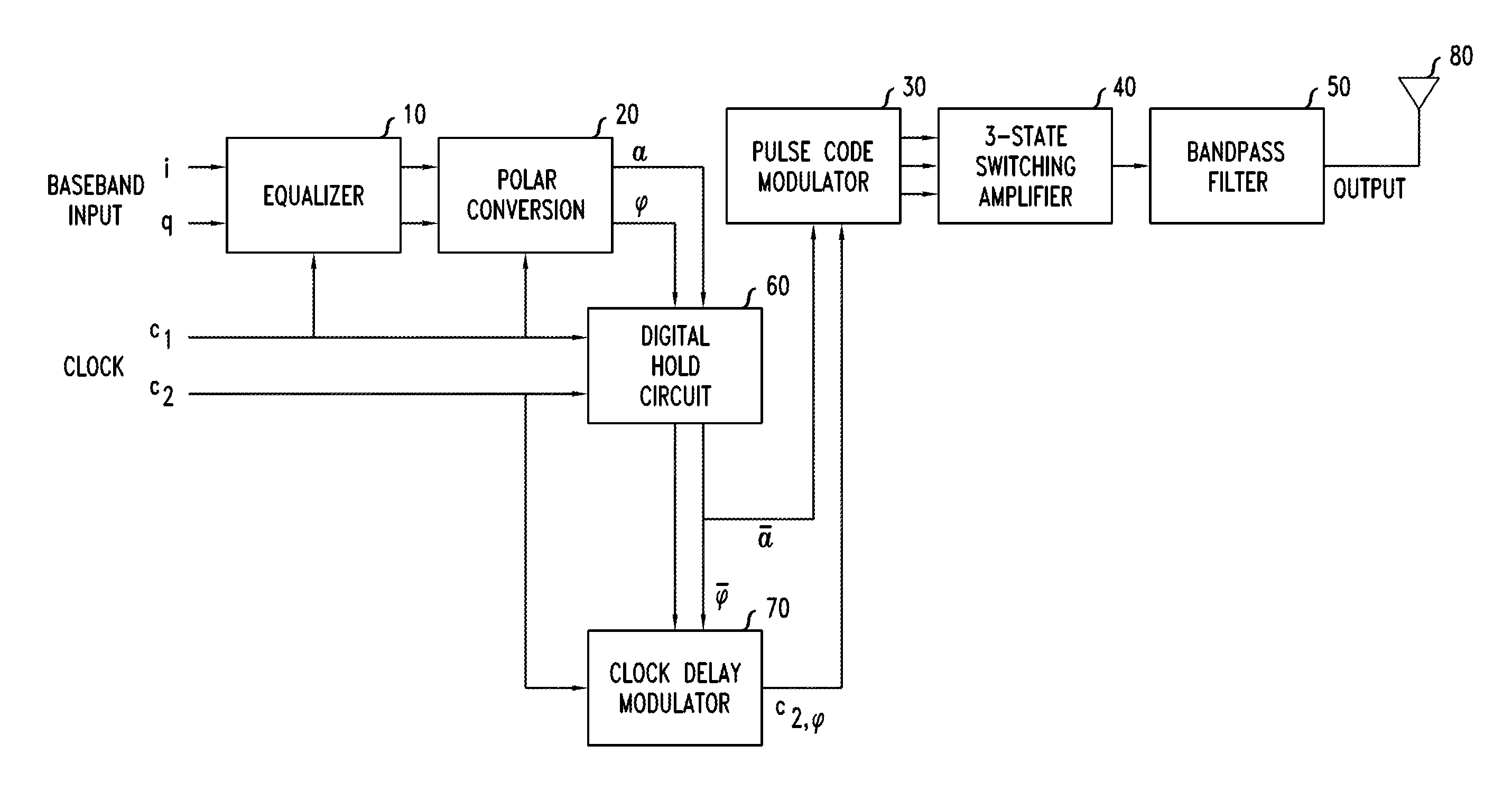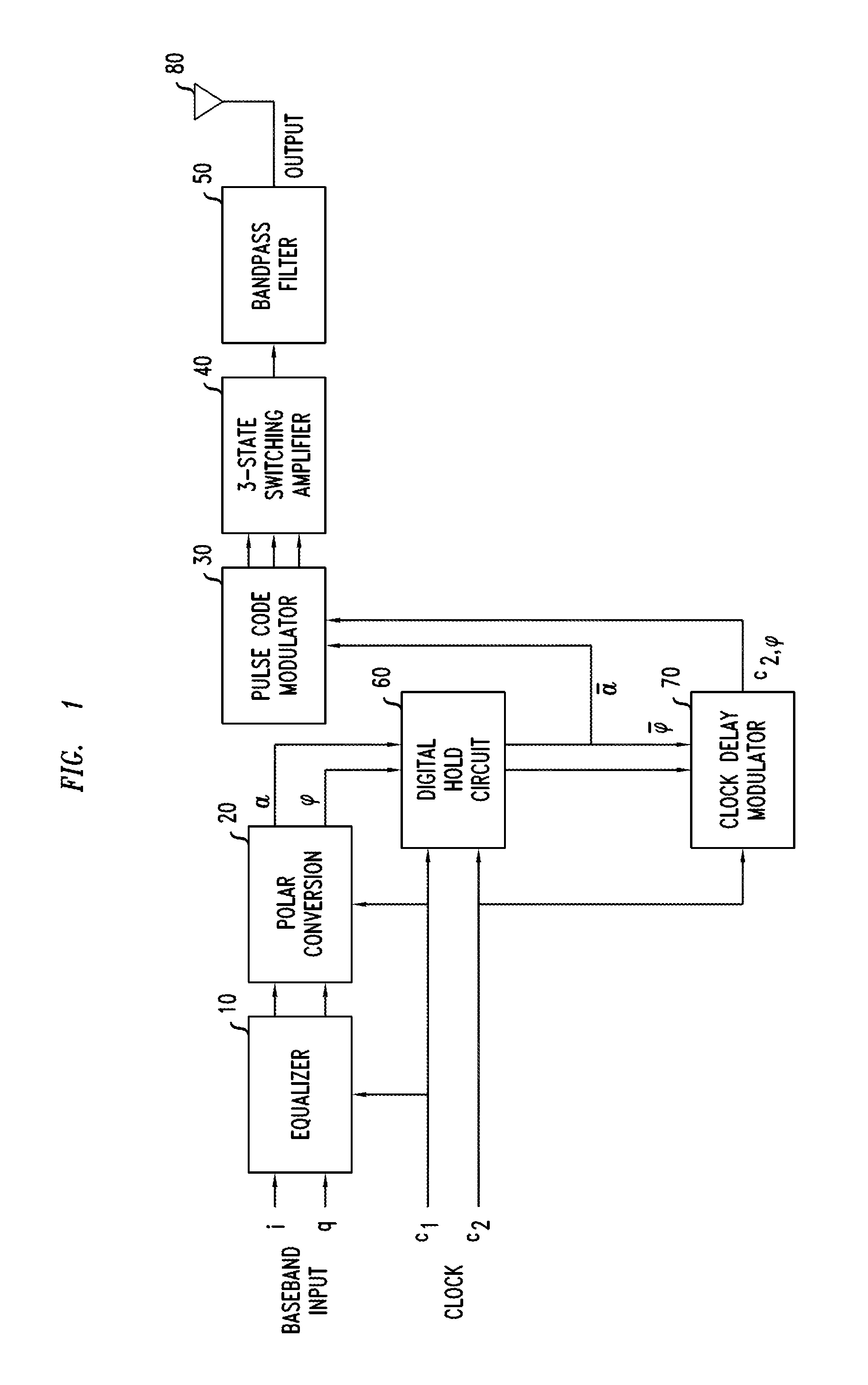Method And Apparatus Of Switched Amplification Having Improved Efficiency
a technology of switching amplifier and efficiency, which is applied in the direction of amplifiers, amplifiers with semiconductor devices/discharge tubes, digital transmission, etc., can solve the problem of limiting the suitability of class s amplifers to coding efficiency, and achieve the effect of reducing power efficiency in amplifiers, reducing power loss in output bandpass filters, and increasing switching rates
- Summary
- Abstract
- Description
- Claims
- Application Information
AI Technical Summary
Benefits of technology
Problems solved by technology
Method used
Image
Examples
example 1
[0076]We performed a numerical simulation of the response of our model system, with a damping factor of 0.005, to a sequence of positive and negative pulses having T=5 and τ=0.5. We took 100 samples per cycle, extended the computation to 200 cycles, and took the last 100 cycles as representative of steady-state behavior. We performed a spectral analysis of the resulting 10,000-sample segment using a Hamming window. The result is shown in FIG. 7a. For a better understanding of the figure, it should be noted that for computational convenience, and without loss of generality, we normalized the center frequency to 1 Hz. As seen in the figure, the center frequency occurs at a normalized frequency of 0.02, which reflects a further normalization factor due to our sampling at 100 samples per cycle and considering the Nyquist rate of two samples per cycle.
[0077]A sequence of spurious tones, which we refer to as spectral “spurs”, are seen in the figure, at frequencies (relative to a center fr...
example 2
[0080]FIGS. 8a and 8b show output spectra for simulations of the response of our model system to pulse codes, as described here, in which a=⅓ and M equals 8 and 32, respectively. The computation was similar to that of Example 1. Comparison of the two spectra shows that when the number of amplitude quantization levels is reduced, additional spurs appear (due to intermodulation) between the main spurs that are associated with pulse skipping. From these results, we expect that intermodulation will not present intolerable difficulties at least when M is at least 8.
example 3
[0081]FIGS. 9a and 9b provide a simple example of pulse-code amplitude modulation combined with phase modulation. Our simulation was modified to include phase modulation according to the clock-delay technique described above, but was otherwise similar to the preceding two examples. We computed the response of our model system to a two-tone suppressed carrier signal x(t), coded with M=16.
[0082]The input signal is given by x(t)=α cos(ω0+Δ)t+(1−α)sin(ω0−Δ)t, where 0≦α≦1 controls the ratio of tone amplitudes and Δ is the tone spacing above and below the center frequency ω0. The amplitude a(t) and phase φ(t) of the input signal are respectively given by
a(t)=[1-2α+2α2+2α(1-α)cos2Δt]1 / 2ϕ(t)=tan-1[(2α-1)sinΔtcosΔt]
[0083]The upper view in FIG. 9a is the waveform for the coded input signal for α=⅓, and the lower view is the corresponding output waveform. It will be seen that the output amplitude varies as a quasi-sinusoid between limits of 0.33 and 1 as expected from the above equations. FIG....
PUM
 Login to View More
Login to View More Abstract
Description
Claims
Application Information
 Login to View More
Login to View More - R&D
- Intellectual Property
- Life Sciences
- Materials
- Tech Scout
- Unparalleled Data Quality
- Higher Quality Content
- 60% Fewer Hallucinations
Browse by: Latest US Patents, China's latest patents, Technical Efficacy Thesaurus, Application Domain, Technology Topic, Popular Technical Reports.
© 2025 PatSnap. All rights reserved.Legal|Privacy policy|Modern Slavery Act Transparency Statement|Sitemap|About US| Contact US: help@patsnap.com



